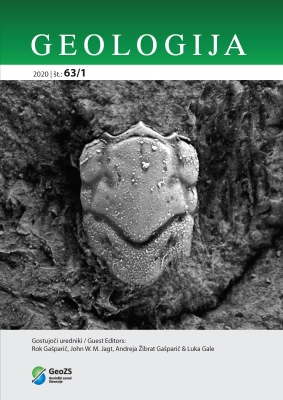Dobro ohranjena kutikula raka Atherfieldastacus magnus (Decapoda, Glypheida) iz aptijskih plasti v Mehiki
DOI:
https://doi.org/10.5474/geologija.2020.004Povzetek
Analiza strukture kutikule fosilnih deseteronožcev je pomembno orodje ne le za paleoekološke in tafonomske interpretacije, ampak tudi kot možen način za sistematsko opredelitev rodov in celo vrst, v kolikor kutikula ni diagenetsko spremenjena. Na podlagi ohranjenosti in primerjave strukture kutikule med primerki iste vrste z različnih nahajališč razlikujemo nahajališča s pogostimi ostanki rakov. Ta lahko kažejo na množičen pogin ali zgolj na akumulacije levov deseteronožcev. V povezavi s prepoznanimi anoksičnimi dogodki v mikrofacialnih analizah nam lahko metoda služi za razlago množičnih nakopičenj fosilnih deseteronožcev na nekaterih lokacijah. Tak primer je zgodnjekredni jastog Atherfieldastacus magnus (M'Coy, 1849), katerega številne ostanke najdemo v različnih litostratigrafskih enotah spodnje krede (predvsem v aptiju) po vsem svetu. V prispevku predstavljamo dobro ohranjeno strukturo kutikule osebkov iz zgornjega aptija iz nahajališča Chihuahua (Mehika). Vzorce tridimenzionalno ohranjene kutikule primerkov iz konkrecij smo pregledali na različnih prečnih presekih z različnih delov telesa jastoga. Tanke plasti kutikule z značilno strukturo kažejo, da gre v našem primeru za trupla, ki so se ohranila v anoksičnem okolju.Prenosi
Kako citirati
González-León, O., Moreno-Bedmar, J. A., Barragán-Manzo, R., & Vega, F. J. (2020). Dobro ohranjena kutikula raka Atherfieldastacus magnus (Decapoda, Glypheida) iz aptijskih plasti v Mehiki. Geologija, 63(1), 39–46. https://doi.org/10.5474/geologija.2020.004
Številka
Rubrika
Članki

